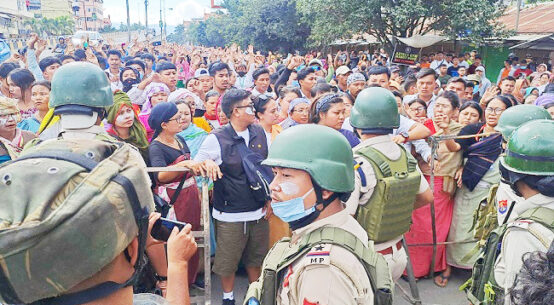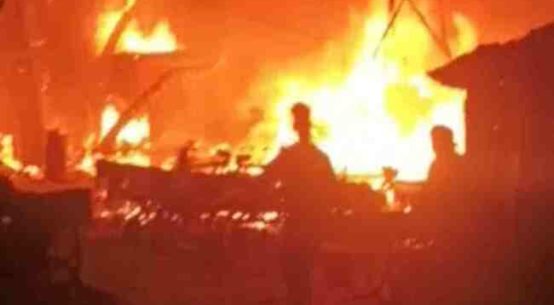One of New York’s wettest days in decades left the metropolitan area stunned and swamped Friday after heavy rainfall knocked out several subway and commuter rail lines, stranded drivers on highways, flooded basements and shuttered a terminal at LaGuardia Airport for hours.
Some 8.65 inches (21.97 centimeters) of rain had fallen at John F. Kennedy Airport by nightfall Friday, surpassing the record for any September day set during Hurricane Donna in 1960, the National Weather Service said.
Parts of Brooklyn saw more than 7.25 inches (18.41 centimeters), with at least one spot recording 2.5 inches (6 centimeters) in a single hour, according to weather and city officials. More downpours were expected Saturday.
The deluge came two years after the remnants of Hurricane Ida dumped record-breaking rain on the Northeast and killed at least 13 people in New York City, mostly in flooded basement apartments. Although no deaths or severe injuries have been reported, Friday’s storm stirred frightening memories.
Ida killed three of Joy Wong’s neighbors, including a toddler. And on Friday, water began lapping against the front door of her building in Woodside, Queens.
“I was so worried,” she said, explaining it became too dangerous to leave. “Outside was like a lake, like an ocean.”
Within minutes, water filled the building’s basement nearly to the ceiling. After the family’s deaths in 2021, the basement was turned into a recreation room. It is now destroyed.
City officials said they received reports of six flooded basement apartments Friday, but all occupants got out safely.
Gov. Kathy Hochul and Mayor Eric Adams declared states of emergency and urged people to stay put if possible. But schools were open, students went to class and many adults went to work, only to wonder how they would get home.
Virtually every subway line was at least partly suspended, rerouted or running with delays. Metro-North commuter rail service from Manhattan was suspended for much of the day but began resuming by evening. The Long Island Rail Road was snarled, 44 of the city’s 3,500 buses became stranded and bus service was disrupted citywide, transit officials said.
“When it stops the buses, you know it’s bad,” Brooklyn high school student Malachi Clark said after trying to get home by bus, then subway. School buses were running, but they transport only a fraction of public school students, many of them disabled.
A long line of people snaked from the ticket counter in the afternoon at Grand Central Terminal, where Mike Tags was among those whose trains had been canceled. Railroad employees had suggested possible workarounds, but he wondered whether they would work out.
“So I’m going to sit here, ride it out, until they open up,” he said.
Traffic hit a standstill earlier in the day on a stretch of the FDR Drive, a major artery along Manhattan’s east side. With water above car tires, some drivers abandoned their vehicles.
Around 11 a.m., Priscilla Fontallio said she had spent three hours in her car, which was on a piece of the highway that wasn’t flooded but wasn’t moving.
“Never seen anything like this in my life,” she said.
On a street in Brooklyn’s South Williamsburg neighborhood, workers were up to their knees in water as they tried to unclog a storm drain while cardboard and other debris floated by. Some people arranged milk crates and wooden boards to cross flooded sidewalks.
Flights into LaGuardia were briefly halted in the morning, and then delayed, because of water in the refueling area. Flooding also forced the closure of one of the airport’s three terminals for several hours. Terminal A resumed normal operations around 8 p.m.
A Brooklyn school was evacuated because its boiler was smoking, possibly because water got into it, Schools Chancellor David Banks said. Another Brooklyn school was mopping up ground-floor classrooms City Councilwoman Crystal Hudson said in an email seeking volunteers to help.
The New York Rangers and New York Islanders postponed a preseason hockey game on Long Island. And at the waterlogged Central Park Zoo, a sea lion swam out of her swollen pool. With the zoo closed because of the weather, she looked around for a bit before returning to the pool, zoo officials said n a statement.
In Brooklyn’s Crown Heights, Jessie Lawrence awoke to the sound of rain dripping from the ceiling of her fourth-floor apartment and heard strange sounds outside her front door.
She opened the door to find “the water was coming in thicker and louder,” pouring into the hallway and flowing down the stairs, she said. Rain had pooled on the roof and was leaking through a skylight.
Hoboken, New Jersey, and other cities and towns near New York City also experienced flooding. New Jersey Gov. Phil Murphy called for state offices to close at 3 p.m., except for essential personnel.
Why so much rain? The remnants of Tropical Storm Ophelia over the Atlantic Ocean combined with a mid-latitude system arriving from the west, at a time of year when conditions coming off the ocean are particularly juicy for storms, National Weather Service meteorologist Ross Dickman said. This combination storm parked itself over New York for 12 hours.
The weather service had warned of 3 to 5 inches (7.5 to 13 centimeters) of rain and told emergency managers to expect more than 6 inches (15 centimeters) in some places, Dickman said.
The deluge came less than three months after a storm caused deadly floods in New York’s Hudson Valley and swamped Vermont’s capital, Montpelier.
As the planet warms, storms are forming in a hotter atmosphere that can hold more moisture, making extreme rainfall more frequent, according to atmospheric scientists.
In the case of Friday’s storm, nearby ocean temperatures were below normal and air temperatures weren’t too hot. Still, it became the third time in two years that rain fell at rates near 2 inches (5 centimeters) per hour in Central Park, which is unusual, Columbia University climate scientist Adam Sobel said.
The park recorded 5.8 inches (14.73 centimeters) of rain by nightfall Friday.


